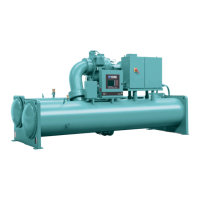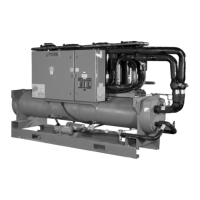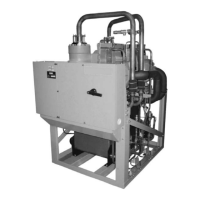System evacuation
WARNING
Ensure power is removed from the input side of the VSD at all times when the chiller is under vacuum
(less than atmospheric pressure). The VSD maintains voltage to ground on the motor when the chiller is
off while voltage is available to the VSD. Insulating properties in the motor are reduced in vacuum and
may not insulate this voltage sufficiently.
After the pressure test has been completed, conduct the vacuum test as follows:
1. Connect a high capacity vacuum pump, with indicator, to the system charging valve as shown
in Figure 55 and start the pump. See Vacuum dehydration.
2. Open wide all system valves. Be sure all valves to the atmosphere are closed and flare caps
installed on outlets.
3. Operate the vacuum pump in accordance with Vacuum dehydration until a wet bulb
temperature of 32°F (0°C) or a pressure of 5 mm Hg is reached. See Table 94 for
corresponding pressure values.
4. To improve evacuation circulate hot water, not to exceed 125°F (51.7ºC) through the
evaporator and condenser tubes to thoroughly dehydrate the shells. If a source of hot water
is not readily available, a portable water heater should be employed. DO NOT USE STEAM.
A suggested method is to connect a hose between the source of hot water under pressure
and the evaporator head drain connection, out the evaporator vent connection, into the
condenser head drain and out the condenser vent. To avoid the possibility of causing leaks,
the temperature should be brought up slowly so that the tubes and shell are heated evenly.
5. Close the system charging valve and the stop valve between the vacuum indicator and the
vacuum pump. Then disconnect the vacuum pump leaving the vacuum indicator in place.
6. Hold the vacuum obtained in Step 3 in the system for 8 hours; the slightest rise in pressure
indicates a leak or the presence of moisture, or both. It is important to check for pressure
change with the chiller at the same temperature. Pressure will change proportional to
temperature and affect results. If after 24 hours the wet bulb temperature in the vacuum
indicator has not risen above 40°F (4.4°C) or a pressure of 6.3 mm Hg, the system may be
considered tight.
Note: Be sure the vacuum indicator is valved off while holding the system vacuum and
be sure to open the valve between the vacuum indicator and the system when checking
the vacuum after the 8 hour period.
7. If the vacuum does not hold for 8 hours within the limits specified in Step 6, the leak must be
found and repaired.
Vacuum dehydration
To obtain a sufficiently dry system, the following instructions have been assembled to provide an
effective method for evacuating and dehydrating a system in the field. Although there are several
methods of dehydrating a system, we are recommending the following, as it produces one of the
best results, and affords a means of obtaining accurate readings as to the extent of dehydration.
The equipment required to follow this method of dehydration consists of a wet bulb indicator
or vacuum gauge, a chart showing the relation between dew point temperature and pressure in
inches of mercury (vacuum), (see Table 94) and a vacuum pump capable of pumping a suitable
vacuum on the system.
YMC
2
Mod B with OptiView
™
Control Center
160

